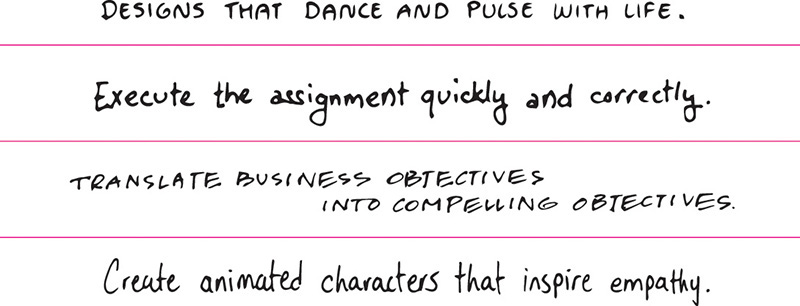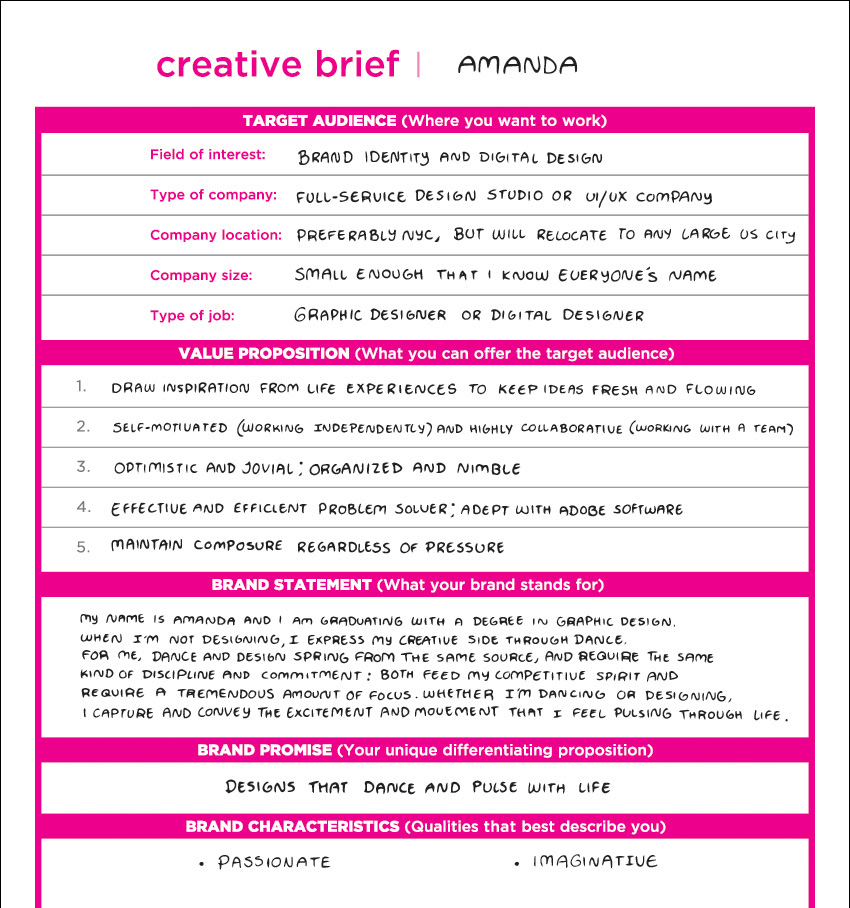2. Develop Your Brand Story
Finding key insights and forming the core of your brand and visual identity.
Now that you’ve collected lots of useful information about the characteristics, skills, personality, and style that comprise your true and authentic self, it’s time to interpret the data and identify key insights that will define your brand. Analyzing your answers, as well as how they compare and contrast with answers that others have provided, will help you articulate who you are in a way that resonates and connects with your audience. A thorough understanding of who you are and how others see you is the foundation on which you’ll build a meaningful, appropriate, and memorable brand.
Look for Insights
An insight is the capacity to gain a true and intuitive understanding of someone or something. According to BusinessDictionary.com, an insight is “feedback; ideas about the true nature of something...; knowledge in the form of a perspective, understanding, or deduction.” For example, in my own survey, when asked what type of dog best illustrates me, four respondents said I was a German Shepherd for being strong, protective, feisty, and loyal. I see myself more as a Standard Poodle, because I am a thinker, am funny, and like to get dressed up. Although the two descriptions are notably different, I can draw an insight from the contrast between my self-image and how others perceive me. In others’ eyes, I come across as more “fierce” than “funny.” If I were developing my personal brand, this characteristic would be worth addressing.
The consistencies in the feedback were even more telling. The answers that the respondents and I shared—creative, passionate, driven, devoted, and entrepreneurial—reveal the undisputed attributes (values, qualities, and characteristics) that make me uniquely me. These insights are evidenced throughout my life and reflect my true and authentic self. I am happily married for 14 years. I have decades-long friendships, and anyone who has ever done business with me knows they can trust me. I am passionately committed to discovering and unlocking my students’ potential. Together, these attributes form the core foundation of my brand and visual identity.
By identifying and summarizing the key insights from your self assessment, you now have the knowledge required to write your brand story and articulate the value you can offer a prospective employer. Your ability to communicate this understanding of yourself will create an emotional connection to your audience.

Develop Your Brand Story
There is no one “correct” way to write a brand story, and as you become more comfortable telling yours, you may choose to devise your own format. For our purposes here, I ask that you follow the formula I describe. It not only provides the essentials that every brand story needs, but it also works.
Think of your personal brand story as being composed of four fundamental elements: the value proposition, the brand promise, the brand statement, and brand characteristics. In previous exercises, you’ve extrapolated key insights about yourself and your goals. Now it’s time to organize what you’ve learned into a compelling story that makes sense and engages your target audience: a potential employer.
For these exercises, you will craft three statements about the fundamental elements of your brand to use as strategic objectives and identify the key characteristics of your brand. Record your answers from all of the exercises on a separate sheet of paper and save it. You’ll need it for your creative brief.

Your value proposition: What can you offer?
“Why should someone hire me?” is an important question to answer, long before a potential employer is cracking open your portfolio. Your value proposition—the contributions you can bring to a project, team, or organization—comprises your positive attributes and the passions and strengths that you can deliver to help a company meet its goals. To determine how you stand out from the crowd, an employer will look carefully at your particular set of capabilities, the functional benefits they offer, and your design and technical skills.
When I hire interns or designers, my final interview question is usually, “What can you do for me?” To answer this or similar questions, you need to know what your value proposition is, and you must be able to articulate it. Focusing on what you bring to the table will help you differentiate yourself.
Understanding how your particular attributes translate into value can help you build a bridge between what you have to offer and an employer’s needs. When the employer sees that your talents, passions, interests, and strengths can be relevant to his or her business, an emotional connection is forged, and your brand is distinguished from others.

Your brand statement: What are you made of?
Every brand, at its innermost core, has a purpose for being. Based on your value proposition, your personal brand statement is a clear and concise articulation of who you are as a person, what value you can deliver to an employer, and why you want to be a designer. Focus on the most important key insights you have identified from your self-assessment and envision the most ideal version of who you are.
Sometimes referred to as an “elevator pitch,” your brand statement should be brief, to-the-point, and easy for your audience to grasp quickly. Your goal is to inspire an emotional connection in no more time than it takes to ride from one floor to another in an elevator. A well-constructed brand statement demonstrates that your commitment is well-thought-out and intentional. It can serve as the springboard for building a mutually valuable and lasting relationship based on your true and authentic self—who you are and what you truly believe.
For example: My name is Amanda, and I am graduating with a degree in graphic design. When I’m not designing, I express my creative side through dance. For me, dance and design spring from the same source and require the same kind of discipline and commitment: both feed my competitive spirit and require a tremendous amount of focus. Whether I’m dancing or designing, I capture and convey the excitement and movement that I feel pulsing through life.

Your brand promise: What can you live up to?
Your brand promise is the single most compelling value you can offer and deliver consistently. It describes your unique selling point, which sets you apart from others. It must be believable, admirable, and differentiating. Let’s say you’re competing with another designer for the same job. It’s unlikely that you’ll know the person you’re competing with, but you can assume that you’ll both have similar educations, skill sets, and work experience. How will a potential employer identify the differences between you? There’s a good chance he or she will consider each candidate’s brand promise to determine who has the attributes, skills, and experiences that will bring the most value to the position. In many cases, it’s not about who’s “better”; it’s about whose promise is most likely to fulfill both the explicit and unstated requirements of that specific job at that particular company.
When I was a young adult, my father—who owned and operated a jewelry store—taught me my first lesson about creating a brand promise, although I didn’t realize it at the time. He said that it doesn’t matter if you lose everything you own; if you have people’s trust, you will always make your way back to the top. His brand promise might have been, “Customers know they can trust me.” The attribute he described was integrity. My father delivered on this promise to his customers, and to his family, every day of his life, and it’s a legacy he bestowed on my siblings and me.

Brand characteristics: What do you want your brand to say about you?
With an understanding of how your perceptions about yourself compare and contrast with others’ perceptions, think about how you will use your attributes to communicate your character. As you move into the next chapter, you’ll want to keep these characteristics in mind so you can make choices about components like fonts, colors, and imagery that are true to the brand you’ve articulated. For example, if one of your attributes is “happy,” then the elements of your identity should be warm and friendly. If you’re a “risk-taker,” then you may choose elements that are edgy and non-traditional.

WORKSHEET:
standoutportfolio.com/self-assessment.pdf
PINTEREST:
pinterest.com/ProfessorDMA/creative-brief/
A creative brief is a one-page document that summarizes the strategic objectives and creative needs of a project for the creative team. Outlining the project’s purpose, target market, brand attributes, value proposition, and a range of other relevant facts, the creative brief informs, guides, and drives the creative strategy. For the purposes of your personal brand, it defines and inspires the meaning of your brand identity.

Develop Your Creative Brief
Before you can define your brand and write your creative brief, you must first visualize where your brand will live and thrive. Much like defining a target audience for a project you’re designing, you need to consider the field you want to work in, the location you want to work from, and the type of job you’d like to do. (See Section 3: Find a Great Design Job.) Addressing these issues will help you assess whether your professional career goals align with your true and authentic self. If you value collaboration, you may not want to work independently from home; if you value honesty and ethics, you probably won’t be happy at an agency with clients who have questionable business practices.
Understanding your ideal destination will help you define a brand identity that will get you there. For example, if you want to work in a design firm doing branding, the art director reviewing your portfolio may gauge how effective your identity design skills are by focusing on your personal logo and other visual components. If you’re looking to work in an advertising agency, the art director may just glance at your personal logo but pay very close attention to whether your other identity touchpoints are executed through a well-thought-out concept and promotion.
It’s time to sum up what you know by putting together a creative brief about you. To complete this exercise, you’ll need the list of answers you created earlier in this chapter so you can complete the Creative Brief worksheet.

